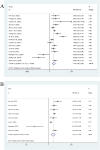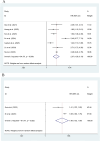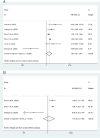A meta-analysis of the prognostic value of the TyG index in heart failure
- PMID: 40778275
- PMCID: PMC12328152
- DOI: 10.3389/fendo.2025.1463647
A meta-analysis of the prognostic value of the TyG index in heart failure
Abstract
Background: Heart failure (HF) is a serious cardiovascular disorder with a poor prognosis, which affects the quality of life and survival in patients. The triglyceride-glucose (TyG) index, a new biomarker for insulin resistance (IR) in the body, has attracted widespread attention from researchers investigating cardiovascular disease (CVD). This study was aimed at assessing the prognostic value of the TyG index in HF patients by a meta-analysis, thereby providing clinicians with a new predictive tool.
Methods: PubMed, Cochrane, EMBASE, and Web of Science were searched for studies (from inception to March 2025) on the association of the TyG index with the prognosis of HF. Meta-analysis was conducted using Stata15. Such association was assessed using a random effects model in conjunction with the hazard ratio (HR) and its 95% confidence interval (CI). In addition, subgroup analysis, publication bias analysis, and sensitivity analysis were performed.
Results: Nineteen studies were included with 44275 HF patients. A significant association was found between an increase in the TyG index and an increase in the risk of all-cause death (ACD) in HF patients (HR=1.70, 95% CI: 1.40-2.08, P<0.001). Increased TyG index predicted major adverse cardiovascular events (MACEs) (HR=2.37, 95% CI: 1.80-3.13, P<0.001) and cardiovascular death (CV death) (HR=1.63, 95% CI: 1.01-2.61, P<0.001). Subgroup analysis showed an association of increased TyG index with a poor prognosis regardless of ejection fraction, and the presence or absence of diabetes. Dose-response analysis showed no linear dose-response relationship (DRR) of the index with ACD, MACEs or CV death.
Conclusion: The TyG index is closely associated with the prognosis of HF. Therefore, it can be used as a prognostic tool for the assessment of HF. A high TyG index may indicate a high risk of ACD and CV events. Therefore, monitoring of the TyG index is significant for risk assessment and management of HF patients. Future studies on the use of the TyG index in therapeutic decision-making for HF are needed.
Systematic review registration: https://www.crd.york.ac.uk/PROSPERO/, identifier CRD42024562063.
Keywords: TyG index; cardiovascular disease; heart failure; meta-analysis; prognosis.
Copyright © 2025 Cai, Yang, Ma, Zhang, Huang and Yu.
Conflict of interest statement
The authors declare that the research was conducted in the absence of any commercial or financial relationships that could be construed as a potential conflict of interest.
Figures







Similar articles
-
Does diabetes status modify the association between the triglyceride-glucose index and major adverse cardiovascular events in patients with coronary heart disease? A systematic review and meta-analysis of longitudinal cohort studies.Cardiovasc Diabetol. 2025 Aug 4;24(1):317. doi: 10.1186/s12933-025-02890-7. Cardiovasc Diabetol. 2025. PMID: 40760488 Free PMC article.
-
Association between insulin resistance indices and outcomes in patients with heart failure with preserved ejection fraction.Cardiovasc Diabetol. 2025 Jan 22;24(1):32. doi: 10.1186/s12933-025-02595-x. Cardiovasc Diabetol. 2025. PMID: 39844150 Free PMC article.
-
Triglyceride-glucose-body mass index and the incidence of cardiovascular diseases: a meta-analysis of cohort studies.Cardiovasc Diabetol. 2025 Jan 22;24(1):34. doi: 10.1186/s12933-025-02584-0. Cardiovasc Diabetol. 2025. PMID: 39844258 Free PMC article. Review.
-
Effects of a gluten-reduced or gluten-free diet for the primary prevention of cardiovascular disease.Cochrane Database Syst Rev. 2022 Feb 24;2(2):CD013556. doi: 10.1002/14651858.CD013556.pub2. Cochrane Database Syst Rev. 2022. PMID: 35199850 Free PMC article.
-
Association between the triglyceride-glucose index (TyG Index) and risk of colorectal cancer: a systematic review and meta-analysis.World J Surg Oncol. 2025 Jul 15;23(1):280. doi: 10.1186/s12957-025-03930-y. World J Surg Oncol. 2025. PMID: 40665300 Free PMC article.
References
-
- James SL, Abate D, Abate KH, Abay SM, Abbafati C, Abbasi N, et al. Global, regional, and national incidence, prevalence, and years lived with disability for 354 diseases and injuries for 195 countries and territories, 1990-2017: a systematic analysis for the Global Burden of Disease Study 2017. Lancet. (2018) 392:1789–858. doi: 10.1016/S0140-6736(18)32279-7, PMID: - DOI - PMC - PubMed
Publication types
MeSH terms
Substances
LinkOut - more resources
Full Text Sources
Medical
Research Materials
Miscellaneous

